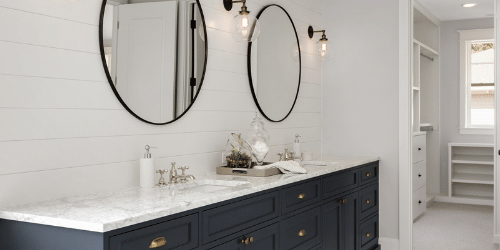Shared bathrooms can be a source of conflict when individual styles clash. This blog post explores how to harmonize different design preferences to create a cohesive and functional space. Whether you’re dealing with contrasting tastes or simply looking to update your shared bathroom, these tips will help you achieve a balanced and stylish environment.
The main point is to find a balance between different styles by incorporating elements that reflect each person’s preferences while maintaining a cohesive overall design.
Understanding Clashing Styles
Identifying Personal Preferences
Consider each person’s favorite colors and how they can be integrated into the overall color scheme. Understanding these preferences allows you to create a space that feels personalized and welcoming. Pay attention to material choices as well, selecting tiles, countertops, and fixtures that align with the desired look and feel. Preferences for materials play a significant role in shaping the kitchen’s character. Additionally, identify preferred design themes, whether modern, rustic, or traditional, to guide the overall aesthetic. Incorporating these elements ensures a cohesive and personalized kitchen design that reflects individual tastes.
Common Sources of Conflict
it’s important to manage contrasting color preferences to avoid color clashes. Find a harmonious balance by selecting complementary shades that satisfy everyone’s tastes. Similarly, balance different material choices to prevent material mismatches. By carefully coordinating textures and finishes, you can create a cohesive look that blends various preferences. Address theme incompatibilities by finding common ground between different design styles, whether it’s blending modern with rustic or traditional with contemporary. This thoughtful approach ensures that the final design feels unified and pleasing to all parties involved.
Importance of Compromise
Encourage open communication during the design process to discuss preferences and compromises. This ensures that everyone’s ideas are heard and considered, leading to a more satisfying outcome. Finding middle ground is key when blending different styles; use techniques like combining elements from each style or choosing a neutral base that allows for varied accents. When conflicts arise or the design process becomes challenging, consider seeking professional guidance from a designer. A professional can provide expert advice, mediate differing opinions, and help create a cohesive design that meets everyone’s needs.
Practical Solutions for Harmonizing Styles
Neutral Base with Accents
Start with neutral colors as a base in your kitchen to create a versatile backdrop that can easily adapt to different styles and preferences. Neutral tones provide a clean, timeless foundation that works well with various accents and themes. Add personality to the space with accent pieces like towels, rugs, and accessories. These items introduce pops of color and character without overwhelming the design. Choose flexible decor that can be easily updated over time, allowing you to refresh the look of your kitchen whenever you like. This approach ensures your kitchen remains stylish and adaptable to changing tastes.
Blending Materials
Incorporate mixed materials in your kitchen by combining different elements in a cohesive way. Thoughtfully blend materials like wood, metal, and stone to create a dynamic yet harmonious design. Ensure consistent finishes throughout the space, such as matching faucets and handles, to maintain a unified look. This attention to detail helps tie the design together, preventing a disjointed appearance. Balance textures carefully by mixing smooth and rough surfaces to add depth and interest without overwhelming the space. A well-balanced mix of materials and textures enhances the overall aesthetic and creates a visually appealing kitchen.
Unified Design Elements
To create a harmonious kitchen design, start by finding a unifying theme that incorporates elements from each preferred style. This common theme serves as the foundation, blending different tastes into a cohesive look. Utilize shared features like mirrors and lighting to further enhance cohesion, ensuring that these elements tie the overall design together. Custom solutions can also play a key role in reflecting both styles, allowing for personalized touches that cater to individual preferences. By customizing elements, you create a unique space that honors each style while maintaining a unified and balanced design.
Design Tips for Shared Bathrooms
Storage Solutions
In a shared bathroom, it’s important to create storage solutions that cater to both users. Design shared storage areas that are easily accessible and functional for everyone. At the same time, allocate personalized storage spaces to give each person a dedicated spot for their belongings. This helps maintain individual organization within a shared environment. Use organizational tools like baskets, trays, and dividers to keep the space tidy and efficient. By combining shared and personal storage with smart organization, you create a bathroom that is both practical and personalized.
Functional Layouts
Design efficient layouts in your bathroom to maximize both space and functionality. Focus on arranging fixtures and storage in a way that makes the most of the available area. Create separate zones for different activities, such as a grooming area, a bathing zone, and a toilet space, to enhance usability and reduce congestion. Ensure the bathroom is accessible for all users, including those with mobility issues, by incorporating features like grab bars, non-slip flooring, and adequate maneuvering space. This approach ensures a practical, comfortable, and inclusive bathroom design.
Aesthetic Balance
Use symmetry to create a balanced and harmonious look in your bathroom design. Symmetrical arrangements, such as matching fixtures or mirrored elements, help achieve visual equilibrium. Create focal points that draw attention away from clashing elements, guiding the eye towards aesthetically pleasing features. Ensure a smooth visual flow throughout the space by coordinating colors, textures, and layouts to enhance overall cohesion. This approach helps unify disparate elements and contributes to a well-rounded and attractive bathroom design.
Case Studies and Examples
Real-Life Examples
Explore diverse bathroom designs with these case studies: Case Study 1 features a blend of modern and rustic styles, combining sleek fixtures with reclaimed wood to create a unique and inviting space. Case Study 2 merges traditional and contemporary elements, using classic features like a pedestal sink alongside modern touches such as frameless glass shower doors for a timeless yet updated look. Case Study 3 showcases a minimalist approach with eclectic accents, where clean lines and simplicity are enhanced by colorful accessories or vintage finds, adding personality and charm to the space.
Lessons Learned
Each case study presents unique challenges: blending styles, balancing design elements, and maintaining functionality. Solutions include careful selection of materials and features to harmonize contrasting styles, strategic layout adjustments to enhance usability, and incorporating versatile design elements. The outcomes show successful integration of various aesthetics, with positive feedback from users highlighting a well-balanced, functional, and visually appealing bathroom. These projects demonstrate how thoughtful design choices and problem-solving can result in highly satisfying and effective bathroom spaces.
Inspiration Gallery
The photo gallery showcases a range of inspiring shared bathroom designs, offering visual examples of various styles and layouts. Design ideas from these photos can spark creativity for your own bathroom remodel, helping you envision how different elements can come together. Additionally, expert tips from designers provide valuable guidance on harmonizing styles, ensuring that your bathroom not only looks great but also functions seamlessly. These resources are essential for creating a space that reflects both personal taste and practical needs.
Answering Common Questions
Q1 How do I choose a color scheme that works for both of us?
A1 Start with neutral colors and add accents that reflect each person’s preferences.
Q2 What if we can’t agree on a design theme?
A2 Find common elements within each theme and blend them to create a cohesive look.
Q3 How can we make a small shared bathroom functional?
A3 Use efficient layouts, shared storage solutions, and multifunctional furniture.
The Impact of Personalization
Personalization plays a crucial role in making a shared bathroom feel comfortable for all users. By incorporating elements that reflect each person’s style, you can create a space that feels uniquely yours.
Seeking Expert Advice
If you’re struggling to harmonize different styles, consider seeking professional guidance. A designer can help you find creative solutions and ensure that the final result is both functional and beautiful.
Conclusion
Creating a harmonious shared bathroom that reflects multiple styles can be a challenging yet rewarding endeavor. By understanding each person’s preferences, finding common ground, and incorporating flexible design elements, you can achieve a balanced and functional space. Remember, open communication and compromise are key to ensuring that everyone feels comfortable and represented in the design. If needed, don’t hesitate to seek professional advice to bring your vision to life. With thoughtful planning and creativity, your shared bathroom can become a stylish and cohesive sanctuary for all users.
Visit us at Pristine Luxury Remodeling
For more information and personalized guidance visit us at Pristine Luxury Remodeling, We specialize in providing exceptional remodeling services that elevate your space into a masterpiece of luxury.







